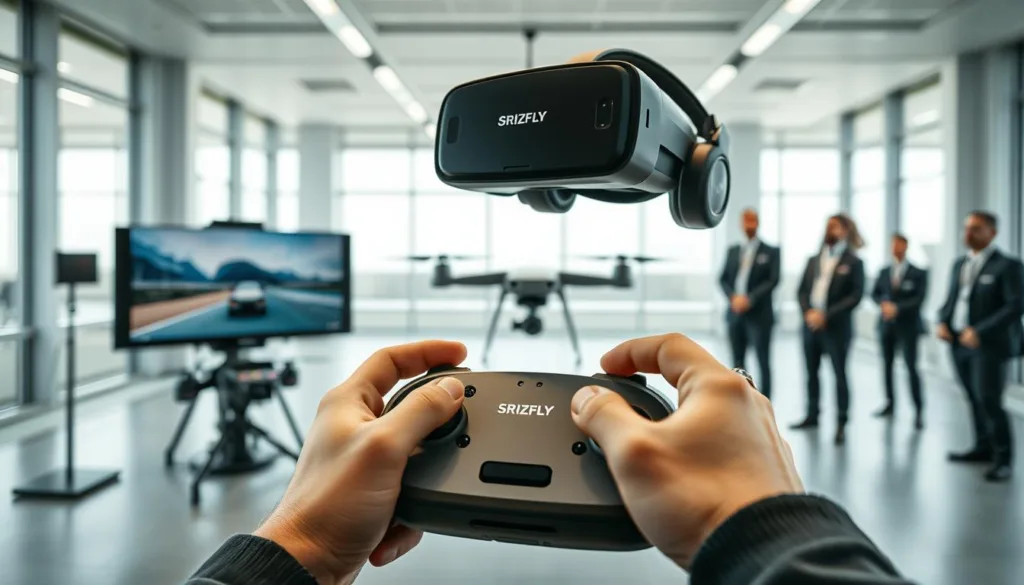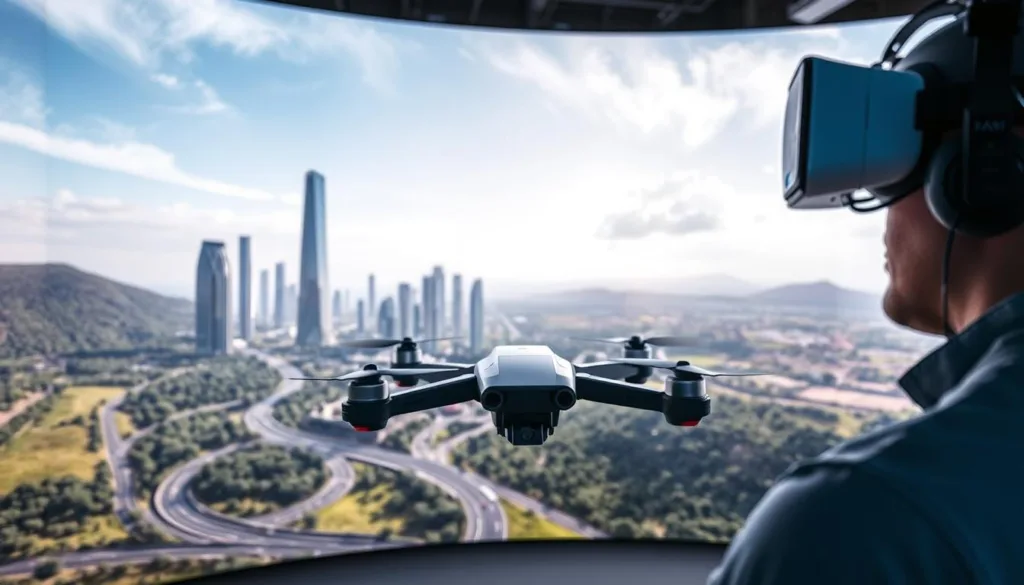SRIZFLY delivers an enterprise-grade solution that puts operators into mission-ready scenarios. We combine Unity3D visuals, Oculus SDK immersion, and C# software design to recreate power inspections, public safety missions, agriculture tasks, and refinery checks.
Our platform targets U.S. operators who need faster readiness with lower risk and cost. With Azure PlayFab and Photon networking, sessions scale from single users to instructor-led teams. We used Scrum across 250 man-days to build repeatable scenarios and clear performance scoring.
What you gain: structured scenarios, measurable outcomes, and practice that translates to field skills. We support FPV hardware makers moving into operator-training software, and we tailor content for audits, certifications, and SOP alignment.
SRIZFLY is your partner for safer, faster training. Try a risk-free trial and see how our platform shortens time-to-readiness and raises safety margins.
Key Takeaways
- Enterprise-ready platform mirrors real-world missions for effective training.
- Scalable sessions support single users and multi-user team exercises.
- Structured scoring and repeatable scenarios build measurable skills.
- Built with Unity3D, Oculus SDK, Azure PlayFab, and Photon for realism and scale.
- Scrum-driven updates keep content current for certifications and SOPs.
Why SRIZFLY’s VR Drone Simulator Matters for U.S. Operators Today
Field crews face rising complexity; they need efficient, repeatable training that maps to real assets.
SRIZFLY compresses learning cycles so users master procedures faster and safer before field deployment. We support basic training, power inspection, public safety, agriculture, mapping, aerial photography, and refinery checks.
Our platform uses C#, Unity3D, and the Oculus SDK for immersion. Cloud backends—Azure PlayFab and Photon—let instructors scale sessions across departments. We built this over 250 man-days with Scrum to meet enterprise expectations for iterative delivery and continuous improvement.
FPV practice is available for confined-area work while line-of-sight principles and checklists stay central. Objective analysis and structured scoring help teams find gaps, standardize responses, and prove readiness to managers and regulators.
- Relevant environments: urban corridors, rural rights-of-way, and industrial sites.
- Reduced field hours: less wear on real drones and lower operational risk.
- Integration-ready: maps to SOPs and compliance workflows for audits.
| Feature | Benefit | Use Case |
|---|---|---|
| Immersive controls | Faster skill transfer | Power line inspection |
| Cloud scaling | Multi-user lessons | Department-wide training |
| Objective analysis | Measurable readiness | Regulatory audits |
| FPV modes | Confined-area confidence | Refinery and interior checks |
Enterprise-Grade Mission Scenarios Built In
Realistic mission libraries help crews build repeatable skills fast and with less risk. We design scenario sets that match field checklists and audit needs. Each scenario is modular and ready for enterprise rollouts.
Electric power inspection: towers, lines, and substations
Power utilities train on towers, lines, and substations with checklist-driven runs. Fault pattern recognition across insulators and connectors is practiced under variable weather. This reduces site time and improves inspection quality.
Public safety and emergency response
Teams rehearse search grids, hotspot ID for firefighting support, and incident command steps. Communication and chain-of-command execution are enforced. The modules mirror real comms and role duties.
Agriculture operations
Operators rehearse crop scouting routes and spraying concepts. Field mapping plans use simulated terrain and boundary markers. This cuts in-field trial-and-error and preserves resources.
Surveying, refinery inspection, and aerial photography
Survey scenarios include photogrammetry-ready flight set-ups, waypoint overlap, and asset-centric passes for accurate downstream analysis. Aerial photography modules teach composition, orbits, and parallax moves. Basic to pro paths build skills from stick control to inspection techniques.
| Mission Type | Primary Benefit | Key Variable |
|---|---|---|
| Power inspection | Reduced field visits | Weather & fault patterns |
| Public safety | Faster coordinated response | Communication protocol |
| Agriculture | Efficient scouting | Terrain & boundaries |
| Survey & refinery | Accurate photogrammetry | Waypoint planning |
Built with Unity3D and the Oculus SDK, our platform was delivered via Scrum across 250 man-days. That lets you scale mission libraries and capture objective analysis for training and audits.
vr drone simulator Modes, Environments, and Training Paths
We structure learning so beginners gain confidence quickly while experienced operators sharpen mission-level skills.
Progressive modes guide pilots from basic stick discipline to advanced workflows. Beginners follow mode-based paths that build altitude control, approach planning, and stabilized landing.
Each path contains formal skill checks and landing assessments. These quantifiable milestones show learning progress before pilots move to higher-stakes missions.

Environments that mirror real sites
Select environments that match your operations: urban canyons, industrial plants, rural fields, and critical infrastructure. Training in matching settings ensures skills translate directly to field work.
FPV segments and instructor tools
FPV practice modules teach spatial awareness and tight-space control, while LOS fundamentals remain central in standard modules. Instructors use cloud-backed sessions—built on Unity3D and the Oculus SDK and scaled via Azure PlayFab and Photon—to run multi-user cohorts and tailor lessons to SOPs.
- Mode-based progression that supports beginners through to pro operators.
- Skill checks and landing metrics to quantify readiness.
- Repeatable drills, actionable feedback, and mission-aligned environments.
Realistic Physics, Controls, and Flight Dynamics
We model the forces that matter so pilots learn to predict behavior before their first live run. Our approach ties authentic physics to mission tasks used in inspection, public safety, and agriculture.
FPV maneuvers, wind impact, and payload changes are all simulated to improve decision-making. Pilots rehearse split-S moves, confined-space orbits, and progressive turns while lateral gusts and ground effect teach subtle corrections.
Configurable control feel for multiple models and components
Profiles represent different drone platforms and components so you can match practice to your fleet. Tuning adjusts thrust, inertia, and aerodynamic drag to make flying feel true to each aircraft.
Payload mass affects climb rate, braking, and battery behavior—so pilots learn to plan approaches and exits with real margins. Energy management and deceleration arcs reduce landing errors on first field deployments.
| Model | Primary Variable | Training Benefit |
|---|---|---|
| Light quad | High thrust, low inertia | Agile maneuvers, quick response |
| Heavy lift | Payload mass & distribution | Approach planning, energy management |
| Industrial kit | Component drag & ground effect | Stable hovering near assets |
Technology Stack and System Architecture
SRIZFLY’s architecture blends real-time networking, asset-optimized models, and modular services for enterprise use.
We built the core with C# and Unity3D and integrated the Oculus SDK for immersive input and visuals. Blender shapes optimized models and components for smooth performance on enterprise hardware.
Backend and networking
Azure PlayFab manages accounts, progression, and content distribution at scale. Photon Unity Networking provides low-latency, multi-user sessions and instructor oversight.
Agile delivery and maintainability
We used Scrum over a 250 man-day effort to deliver the app and keep iterative updates flowing. That process lets us push physics, scenarios, and UI fixes quickly.
- Modular growth: add mission packs without downtime.
- Shared subsystems: FPV and LOS sequences reuse core services for consistency.
- Enterprise-ready: integration points and app-level configs meet IT policies.
Our engineering demonstrates end-to-end software design and system development you can trust for mission-critical training.
FPV Drone Simulator vs. Line-of-Sight and Enterprise Training Use Cases
Teams that face catwalks, ducts, or cluttered interiors need focused practice that mirrors those constraints.

When to train FPV drones for tight spaces and rapid maneuvers
Use an FPV track when missions require tight precision, rapid repositioning, or single-operator visual control inside structures.
FPV training emphasizes camera orientation, line choice, and throttle modulation to protect assets and people. We build progressive maneuvers and controlled descents so pilots develop pro-level skills safely.
Enterprise mission sets emphasizing safety, inspection, and analysis
For LOS operations—inspection, mapping, and incident documentation—we align training to SOPs, checklists, and objective data capture.
Instructors compare FPV vs. LOS outcomes to pick the safest, most efficient approach per task. Multi-user sessions with Photon let teams rehearse comms and airspace coordination under instructor oversight.
- FPV drones excel in confined environments; LOS fits wide-area inspections.
- Clear metrics show when a pilot can move from FPV practice to operational deployments.
- Explore our best FPV drone simulator for beginners and enterprise pathways: best FPV drone simulator.
Hardware, Control Options, and Compatibility
Flexible hardware and app integrations keep training aligned with field kits and classroom setups. We support mainstream headsets through the Oculus SDK and common controllers so sessions feel familiar to users.
Headsets, controllers, and app integrations for realistic operation
Our platform maps sticks, switches, and gimbals to match your fleet of drone models. That input calibration makes handling consistent across models and reduces transition time to live flights.
Input calibration, time-of-day, and weather configuration options
You can set time and weather to mimic dawn inspections, glare, or low-light checks. Options also include camera FOVs, gimbal speeds, and HUD overlays to meet operational safety needs.
FPV practice benefits from precise headset response and low-latency control. For LOS workflows, standard controller layouts and telemetry readouts reinforce checklist discipline.
| Compatibility Area | What We Support | Training Benefit |
|---|---|---|
| Headsets | Oculus SDK and mainstream HMDs | Immersive, low-friction setup |
| Controllers | Standard RC layouts, mapped gimbals | Field-like handling across models |
| Facility Ops | Charging plans, classroom rotation | High throughput without downtime |
| Environment | Time-of-day & weather presets | Schedule-ready, repeatable runs |
Scenario Modules and Enterprise Add‑Ons
Focused modules translate SOPs into step-by-step practice that crews can scale. Each module is an independent training set you can add or update via our add-on model. This keeps content aligned to evolving missions and compliance needs.
Public safety module: target identification, waypoint control, and comms
Our public safety module trains target ID, waypoint-based sector searches, and concise comms for incident command. Instructors run timed sector sweeps and validate handoffs so teams rehearse real response rhythms.
Power inspection module: asset-centric checklists and fault pattern training
The power inspection module focuses on asset-centric passes and visual fault patterns—cracked insulators, corrosion markers, and connector faults. Checklists guide each flight pass to standardize inspections and reduce field time.
Survey & mapping module: flight planning, terrain following, and landing drills
Survey & mapping includes flight planning, overlap metrics, terrain-following, and precise landing drills. Coverage goals and automated image analysis show when a team meets mapping thresholds for downstream processing.
- FPV practice can be layered into modules for confined infrastructure without compromising safety.
- Each set supports skills validation and a clear readiness record before live assignments.
- Content updates use Unity3D + Oculus SDK and scale via Azure PlayFab and Photon Unity Networking; Scrum keeps modules current.
How SRIZFLY Compares in the Drone Software Ecosystem
SRIZFLY focuses on skill building and operational readiness, not on replacing post-flight analysis or fleet management apps. We design training that feeds cleaner, more consistent data into downstream toolchains used for mapping, thermal review, and fleet oversight.
Training-focused simulation vs. post-processing and analysis toolchains
SRIZFLY is training-first: our platform builds pilot discipline and capture consistency so work that reaches DJI Terra, FlightHub 2, or thermal analysis tools is higher quality.
Better training reduces missed passes and retakes. That saves time in post-processing and improves final deliverables.
Positioning alongside ecosystem apps like assistants and thermal tools
We sit alongside assistant-style apps (DJI Assistant 2 series, DJI Virtual Flight) and fleet or analysis solutions. SRIZFLY prepares teams so those apps can do what they do best: planning, editing, and advanced analysis.
| Role | Primary Focus | How SRIZFLY Adds Value |
|---|---|---|
| Training platform | Skill building and readiness | Standardizes capture procedures and measurable scores |
| Post-processing tools | Mapping, thermal, and editing | Receive more consistent inputs; fewer retakes |
| Fleet & assistant apps | Configuration, logs, and mission planning | Training ensures pilots follow planned waypoints and checklists |
- Complementary workflow: we improve capture quality so analysis outputs are more reliable.
- FPV capabilities: prepare teams for confined inspections while LOS paths cover wide-area mapping.
- Measurable outcomes: repeatable missions and performance scores integrate with QA and reporting.
Bottom line: SRIZFLY is the platform for building operator skill and safety. Specialized apps then handle flight control, fleet management, or deep analysis.
Deployment, Implementation, and Measurable Training Outcomes
A clear rollout and logging process lets teams prove readiness and reduce field risk. We deliver a complete solution—from setup to analytics—so enterprises can manage users, track sessions, and quantify improvements across modules and missions.
System setup, user management, and session logging on the platform
Fast system setup: administrators configure permissions, profiles, and device groups in minutes. Azure PlayFab handles accounts and progression while Photon Unity Networking runs secure multi-user sessions.
User management: assign roles, cohorts, and devices so training scales across locations. Session logging records attempts, completions, and key events for every user.
Skill analytics, performance scoring, and readiness metrics over time
Skills analytics highlight strengths and gaps. Performance scoring benchmarks pilots against mission KPIs and enterprise standards.
FPV and LOS tracks are logged consistently to enable apples-to-apples comparisons. Managers export readiness metrics for audits and leadership reports. Our Agile process adds reporting enhancements over time so you retain visibility as missions evolve.
| Area | Capability | Benefit |
|---|---|---|
| Setup | Accounts, permissions, device profiles | Fast, secure onboarding |
| Users & cohorts | Role-based groups and device mapping | Organized, scalable training |
| Logging & events | Session attempts, completions, key events | Audit-ready records |
| Analytics | Skills gaps, scores, trend exports | Data-driven readiness and ROI |
Conclusion
SRIZFLY closes the gap between classroom practice and confident field flight with measurable outcomes. We deliver an enterprise-grade solution that covers power inspection, public safety, agriculture, surveying, aerial photography, and refinery checks.
Built on C#, Unity3D, and the Oculus SDK, and scaled via Azure PlayFab and Photon, our platform reflects 250 man-days of Scrum-driven engineering. That work gives you repeatable scenarios, realistic physics, and flexible control tuning for diverse drone models.
Choose SRIZFLY to speed skill development for beginners and pro pilots. Try the 10-day free trial to validate fit and measure impact. Thanks for considering SRIZFLY as your training solution for safer, more efficient operations.
FAQ
What is SRIZFLY and how does the VR system improve training efficiency?
SRIZFLY delivers an immersive training platform that reduces real-world flight hours and risk. Our solution uses realistic physics, configurable flight controls, and mission scenarios to accelerate skill acquisition—customers report up to 50% faster proficiency in core maneuvers. We combine simulation with analytics so you track progress and certify readiness.
Which mission scenarios are included for enterprise operations?
The platform ships with built-in scenarios for electric power inspection, public safety and emergency response, agriculture operations, surveying & mapping, and aerial photography. Each scenario includes task-driven objectives, environmental variations, and failure modes to mirror real inspections, photogrammetry workflows, and incident responses.
How does the system handle different skill levels from beginners to pros?
Training paths progress from beginner to pro with adaptive skill checks and landing modules. Novice pilots start with fundamentals—takeoff, hover, and safe landing—while advanced modules cover FPV maneuvers, tight-space flight, and mission planning. Each path adapts difficulty and issues performance feedback.
Are the flight physics and control dynamics realistic?
Yes. We model wind impact, payload effects, and component-level behavior to match operational performance. Control feel is configurable for multiple drone models and hardware profiles, giving accurate handling for inspection, mapping, or first-person view work.
What technology underpins the SRIZFLY platform?
The stack is built in C# on Unity3D with Oculus SDK support for immersion. Networking and scaling use Azure PlayFab and Photon Unity Networking. Our development follows Scrum for regular updates and quick feature delivery.
When should teams train FPV flight versus line-of-sight operations?
Train FPV for tight corridors, rapid maneuvers, and complex inspections where visual line-of-sight is limited. Line-of-sight training focuses on broader situational awareness and regulatory compliance. We recommend both: FPV for confined missions and LOS for routine enterprise operations.
What hardware and control options are compatible?
The platform supports major headsets and commercial controllers, plus app integrations for mobile and desktop. Input calibration, time-of-day, and weather settings are configurable to match operational kits and environmental conditions. We test with common radio transmitters and commercial camera payloads.
Can I add enterprise modules like public safety or power inspection?
Yes. Modular add-ons include public safety (target ID, comms, waypoint control), power inspection (asset checklists, fault patterns), and survey & mapping (flight planning, terrain-following, and landing drills). Modules integrate with user management and session logs for training records.
How does SRIZFLY position against other software in the ecosystem?
SRIZFLY focuses on training and operational readiness rather than post-processing. We complement flight planning and thermal analysis tools by preparing pilots to collect higher-quality data. Our platform integrates with common toolchains to streamline field-to-analysis workflows.
What deployment and implementation support do you provide?
We offer system setup, user management, and session logging on the platform, plus instructor controls and scalable backend deployment. Onboarding includes configuration for your hardware, curriculum mapping, and measurable skill analytics to track readiness over time.
How are training outcomes measured and reported?
The platform captures performance metrics, skill scores, and readiness trends. Administrators access dashboards for session history, error patterns, and progression metrics. This data helps optimize training plans and validate proficiency for operational teams.
Is there a trial or proof-of-concept available?
We provide a 10-day free trial to evaluate features, environments, and integration with your hardware. This risk-free period lets teams validate training impact and compare performance against existing programs.



